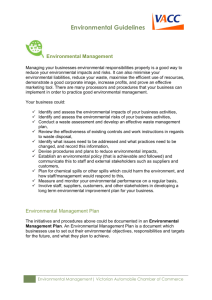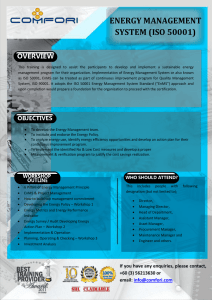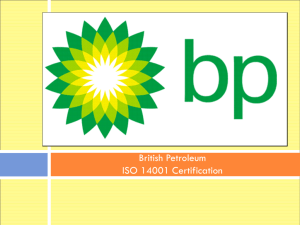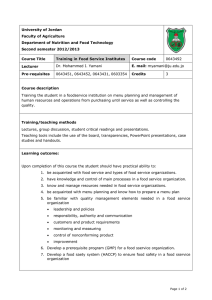ISO 14000 Environmental Management Standards: Their Relation to Sustainability P. Elefsiniotis
advertisement
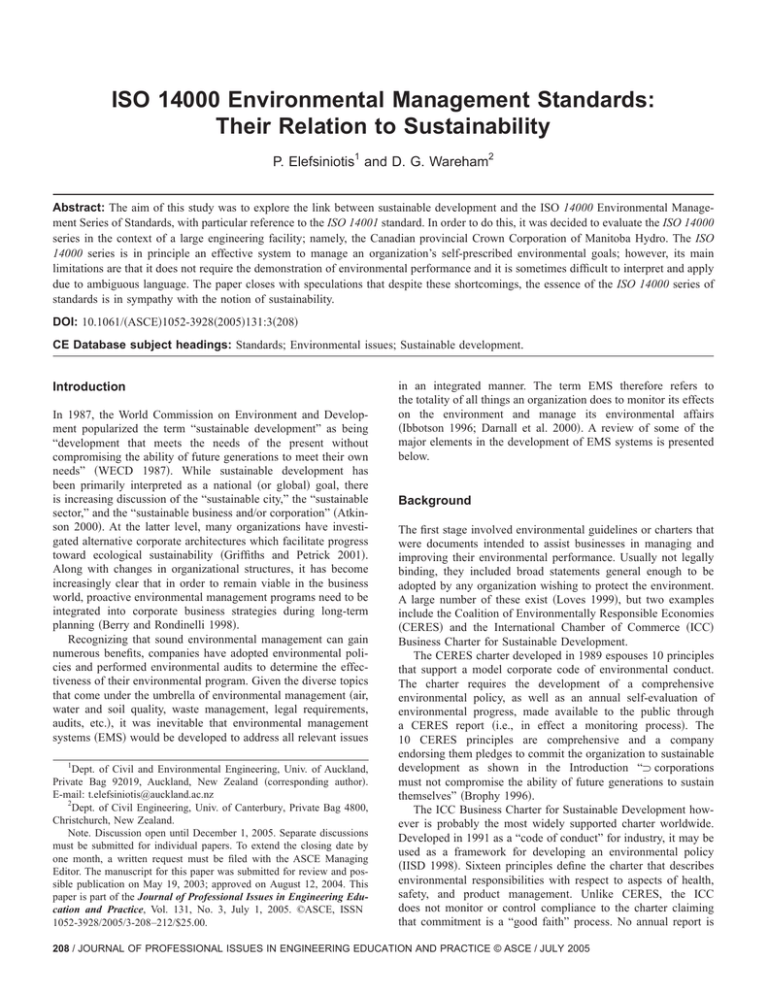
ISO 14000 Environmental Management Standards: Their Relation to Sustainability P. Elefsiniotis1 and D. G. Wareham2 Abstract: The aim of this study was to explore the link between sustainable development and the ISO 14000 Environmental Management Series of Standards, with particular reference to the ISO 14001 standard. In order to do this, it was decided to evaluate the ISO 14000 series in the context of a large engineering facility; namely, the Canadian provincial Crown Corporation of Manitoba Hydro. The ISO 14000 series is in principle an effective system to manage an organization’s self-prescribed environmental goals; however, its main limitations are that it does not require the demonstration of environmental performance and it is sometimes difficult to interpret and apply due to ambiguous language. The paper closes with speculations that despite these shortcomings, the essence of the ISO 14000 series of standards is in sympathy with the notion of sustainability. DOI: 10.1061/共ASCE兲1052-3928共2005兲131:3共208兲 CE Database subject headings: Standards; Environmental issues; Sustainable development. Introduction In 1987, the World Commission on Environment and Development popularized the term “sustainable development” as being “development that meets the needs of the present without compromising the ability of future generations to meet their own needs” 共WECD 1987兲. While sustainable development has been primarily interpreted as a national 共or global兲 goal, there is increasing discussion of the “sustainable city,” the “sustainable sector,” and the “sustainable business and/or corporation” 共Atkinson 2000兲. At the latter level, many organizations have investigated alternative corporate architectures which facilitate progress toward ecological sustainability 共Griffiths and Petrick 2001兲. Along with changes in organizational structures, it has become increasingly clear that in order to remain viable in the business world, proactive environmental management programs need to be integrated into corporate business strategies during long-term planning 共Berry and Rondinelli 1998兲. Recognizing that sound environmental management can gain numerous benefits, companies have adopted environmental policies and performed environmental audits to determine the effectiveness of their environmental program. Given the diverse topics that come under the umbrella of environmental management 共air, water and soil quality, waste management, legal requirements, audits, etc.兲, it was inevitable that environmental management systems 共EMS兲 would be developed to address all relevant issues 1 Dept. of Civil and Environmental Engineering, Univ. of Auckland, Private Bag 92019, Auckland, New Zealand 共corresponding author兲. E-mail: t.elefsiniotis@auckland.ac.nz 2 Dept. of Civil Engineering, Univ. of Canterbury, Private Bag 4800, Christchurch, New Zealand. Note. Discussion open until December 1, 2005. Separate discussions must be submitted for individual papers. To extend the closing date by one month, a written request must be filed with the ASCE Managing Editor. The manuscript for this paper was submitted for review and possible publication on May 19, 2003; approved on August 12, 2004. This paper is part of the Journal of Professional Issues in Engineering Education and Practice, Vol. 131, No. 3, July 1, 2005. ©ASCE, ISSN 1052-3928/2005/3-208–212/$25.00. in an integrated manner. The term EMS therefore refers to the totality of all things an organization does to monitor its effects on the environment and manage its environmental affairs 共Ibbotson 1996; Darnall et al. 2000兲. A review of some of the major elements in the development of EMS systems is presented below. Background The first stage involved environmental guidelines or charters that were documents intended to assist businesses in managing and improving their environmental performance. Usually not legally binding, they included broad statements general enough to be adopted by any organization wishing to protect the environment. A large number of these exist 共Loves 1999兲, but two examples include the Coalition of Environmentally Responsible Economies 共CERES兲 and the International Chamber of Commerce 共ICC兲 Business Charter for Sustainable Development. The CERES charter developed in 1989 espouses 10 principles that support a model corporate code of environmental conduct. The charter requires the development of a comprehensive environmental policy, as well as an annual self-evaluation of environmental progress, made available to the public through a CERES report 共i.e., in effect a monitoring process兲. The 10 CERES principles are comprehensive and a company endorsing them pledges to commit the organization to sustainable development as shown in the Introduction “…corporations must not compromise the ability of future generations to sustain themselves” 共Brophy 1996兲. The ICC Business Charter for Sustainable Development however is probably the most widely supported charter worldwide. Developed in 1991 as a “code of conduct” for industry, it may be used as a framework for developing an environmental policy 共IISD 1998兲. Sixteen principles define the charter that describes environmental responsibilities with respect to aspects of health, safety, and product management. Unlike CERES, the ICC does not monitor or control compliance to the charter claiming that commitment is a “good faith” process. No annual report is 208 / JOURNAL OF PROFESSIONAL ISSUES IN ENGINEERING EDUCATION AND PRACTICE © ASCE / JULY 2005 released, however, the charter requires that “regular audits and assessments of compliance” be performed, and that appropriate information be periodically communicated to the board of directors, shareholders, employees, the authorities, and the public. Assessments however need not be scheduled, consistent or comparable, and the released information is left to the organization’s discretion 共Phyper and Ibbotson 1996兲. Although the charter’s title includes sustainable development, the principles do not explicitly reflect this concept as in the CERES principles. Many existing charters contain principles that can be classed as commonsense, however, the style in which they are written can cause repudiation of a charter. For example, the CERES charter makes a direct commitment to action, which to some organizations appears too demanding and unrealistic to adopt. Thus, the trend for many industries is to opt for other less demanding and less stringent charters 共Brophy 1996兲. Although many charter principles provide the qualitative framework that underpins the development of an environmental management system, the need to ensure a certain consistency in EMS quality led to the second stage, which involved the development of several national but voluntary environmental management system standards in the 1990s. The first standard to emerge was the British Standard 7750 (BS 7750) developed by the British Standards Institution 共BSI兲 in 1992. This was followed by the European Union’s 共EU兲 Eco-Management and Audit Scheme 共EMAS兲 in 1993. At the same time, within the EU, other nations chose to develop their own standards. Ireland developed IS 310, France X30-200, and Spain developed UNE77801. Outside Europe, South Africa developed SABS-0251, Canada developed CSA 7750, while others simply chose to adopt BS7750 as their national EMS standard. Although all provide similar elements, variations in their levels of detail, implementation procedures, and requirements for accreditation led to confusion in defining the relative significance of the various standards. This raised the necessity for one international standard that could cross national boundaries. In late 1996, the long awaited international environmental management standard, the ISO 14000 series was published, with the intention of crossing all trade and political borders, as well as being applicable to any kind of organization 共GEMI 1996; Starkey 1996兲. ISO, as the International Organization for Standardization is more commonly known, is not an acronym, but is in fact derived from the Greek word ISO, meaning “equal. ” The ISO’s focus was initially on technical/scientific standards but in the 1980s, technical committee 共TC 176兲 developed a quality management standard in order to standardize one aspect of organizational management. The result was the ISO 9000 series of international, generic quality management standards adopted in 1987. In 1993, TC 207 was created to develop a number of environmental standards in different areas including standardization in the field of environmental management, tools, and systems. The scope of the ISO 14000 environmental series of standards was similar to the ISO 9000 standards in that the environmental standards were process quality standards 共Von Zharen 1996; Baker and McKeil 1998兲, and as such would not specify final product quality objectives 共Cascio et al. 1996兲. ISO 14000 is therefore a series of environmental standards aimed at providing organizations with a structured framework to manage their environmental impacts and responsibilities; however, the emphasis is on the management process which aims to be consistent and which in turn should generate products of consistent quality. Some of the ISO 14000 series 共the Organization Evaluation group兲 concentrate on the organization’s management, environ- mental auditing, and environmental performance evaluation systems, while others 共the Product Evaluation group兲 include such things as environmental labeling, life cycle assessment procedures, and product standards. In the latter case, there is an intuitive link to sustainable development because practices such as Design for the Environment can be included, which involve answering questions about the life cycle of the product and its production process 共DeMendonça and Baxter 2001兲. Although the Product Evaluation link to sustainability is strong, limited work has been done on assessing how the first group of ISO 14000 series promotes the notion of sustainable development. In other words, it has been recognized by some companies that they have now become “clean”—but is that the same thing as “sustainable?” One aspect of this stems from the fact that many companies set targets long before they formalized their EMS. The implementation of a standardized EMS may have helped them achieve their goals more effectively, but it may not necessarily have led to a change in the goals themselves; thus, many companies advocate that they would have achieved their environmental goals 共i.e., become “green”兲 regardless of the EMS 共Steger 2000兲. The aim of this research was therefore to explore the ways and means the first group of standards 共i.e., the Organization Group兲 promotes the notion of sustainable development. In order to do this it was decided to evaluate the ISO 14000 series of standards in the context of a large engineering facility; namely, the Canadian provincial Crown Corporation of Manitoba Hydro. The study focused on the Organization Evaluation standards within the ISO 14000 series referring specifically to the ISO 14001 EMS specification, and the supporting guidance documents and environmental auditing standards 共ISO 1996a,b,c兲. Discussion Manitoba Hydro’s Environmental Management Systems As a member of the Canadian Electricity Association, Manitoba Hydro participates in a required, industry-wide environmental initiative known as the Environmental Commitment and Responsibility 共ECR兲 program. Within the program, each electric utility is given freedom to determine the direction and scope of implementation best suited for their organization; thus, to indicate the extent of their commitment to the environment, Manitoba Hydro adopted 13 “principles of sustainable development” which far surpass the minimal requirements of ISO 14001 共Dennis Windsor, personal communication, May 15, 1998兲. Manitoba Hydro resolved to develop and implement four EMSs within the corporation: one for each of four respective business units; corporate, power supply, transmission and distribution, and customer service and marketing. To start with, Manitoba Hydro began to develop EMSs for the corporate and power supply business units. The power supply business unit has 6 divisions: Finance and Administration, Power Planning, Generation North 共6 hydraulic generating stations兲, Generation South 共8 generating stations兲, High Voltage Direct Current 共3 converter facilities兲, and Operations and Engineering Services. It was decided that each separate facility/operation was to develop their own Local EMS 共LEMS兲, and that the cumulative LEMS would establish the Business Units’ EMS. Each facility/operation would have its own environmental objectives that must include the corporate environmental policy and conform to the overall JOURNAL OF PROFESSIONAL ISSUES IN ENGINEERING EDUCATION AND PRACTICE © ASCE / JULY 2005 / 209 business plan. As there are many overlaps and linkages between business units, the same would be true for the EMSs. Manitoba Hydro then elected to develop an EMS for each Business Unit comprised of cumulative LEMS. Two approaches can be taken with regards to certification although it is not required by the ECR, since only the implementation of an ISO-like EMS is required. The first approach involves individual site certification which allows gradual certification of units as soon as the LEMS are implemented. Since this approach does not depend on the progress of other units, it shows immediate commitment to the environment; however, individual site registrations can result in less cohesiveness between the systems. The second approach involves certifying each of the business units, which although more complicated would ensure an overall better corporate wide system cohesiveness. Manitoba Hydro selected the first approach and their first six power stations were certified by the year 2000 共Manitoba Hydro 2000兲. General Criticisms of ISO 14000 Series and Their Application to Manitoba Hydro As mentioned, the ISO 14000 series offer an organization the tools and systems to manage their environmental responsibilities. Much confusion however has arisen about the standards within the series, for example, ISO 14001. It is commonly misconceived as a “performance” standard for the environment by both the public and experienced environmental professionals alike. Indeed, many staff at Manitoba Hydro had this impression at the start of this research 共Dennis Windsor, personal communication, June 5, 1998兲. The assumption that the ISO has set standards for environmental protection is reported elsewhere 共Gleckman and Krut 1997兲, but in fact, as intimated earlier, the ISO series are “process” rather than performance and/or “compliance” standards. Although the series were developed according to the mandate of their authors, many therefore believe that they do not make enough of a commitment to the environment and, that in order to mitigate pollution, environmental goals are required 共Cascio et al. 1996兲. Another point of confusion arises because compliance with the ISO specification requires conformance to the series, not the demonstration of environmental performance. As a management system addressing environmental issues, the premise behind the specification is that if the system is continually improved, eventually so should the organization’s environmental performance. Although implied, compliance and/or certification does not mean that the organization produces more environmentally sound products, or that its activities or services are more environmentally sensitive. Improvements in the environmental management system are intended to result in additional improvements in environmental performance, but, as ISO 14001 states, adopting the standard will not in itself guarantee optimal environmental outcomes 共ISO 1996a兲. Thus, two organizations that have different environmental performance and different goals may both be in conformation with the specification, and may therefore be certified 共ISO 1996a兲. A third issue involves the actual certification process. When an organization seeks certification, it defines the scope of the certification audit. This may include single or multiple sites, facilities, or processes, and may exclude others. The idea is to offer a corporation the flexibility to register units separately, as Manitoba Hydro has opted 共Manitoba Hydro 2000兲 or under one certificate. However, this flexibility also allows for a misleading situation to arise, whereby a facility receives ISO 14001 certification, but only for their narrowly defined scope. Such an occurrence took place in Ontario Hydro, where a nuclear generating station was ISO 14001 certified, but the scope of the audit excluded the nuclear generating process, which can potentially impact the environment significantly 共C. Camplong, personal communication, 1998兲. Should a serious situation arise at this facility, it would reflect badly on all utilities, while discrediting the ISO certification process and potentially the ECR program. Additionally, the organization, within its policy, is required to commit to comply with relevant environmental legislation and other requirements. Surprisingly, an organization can be certified to the ISO 14001 standard while not being in compliance with all relevant environmental legislation. The organization must only be able to demonstrate conformance to the system 共commitment to comply兲 rather than compliance to legislation. During an environmental certification audit, auditors will verify that these commitments are fulfilled, in addition to the requirements of the standard. In the case of Manitoba Hydro, “other requirements” refers to their sustainable development principles, ECR, and all other programs, initiatives, and commitments made. Another criticism that is an impediment to embracing the ISO 14000 series is the language used in the standards. Unclear wording that is open to broad and varied interpretation poses difficulties for any organization implementing the series. This was a common complaint that surfaced among the staff at Manitoba Hydro 共Loves 1999兲. The consequence of unclear wording is that the organization cannot be sure that its interpretations will match those of the external certification auditor should the organization choose to become certified. Clarity and consistency in the series definitions of various tools and strategies and their order of preference would make it easier for facilities to understand what they should be striving toward to improve their EMSs 共Barkett 1998兲. For example, the ISO 14001 standard has a requirement that a commitment be made to continual improvement of the EMS and to prevention of pollution, defined as “use of processes, practices, materials or products that avoid, reduce or control pollution, which may include recycling, treatment, process changes, control mechanisms, efficient use of resources and material substitution.” The phrase “prevention of pollution” therefore includes “end of pipe” solutions which is different from pollution prevention as commonly understood in the United States 共where it is more in line with the concept of “source reduction”兲. Since a commitment to prevention of pollution is stated in the policy section of the standard, inclusion of a waste minimization hierarchy may help to elucidate what a “commitment to prevention of pollution” actually means. ISO 14001 requires that an organization’s “environmental aspects” over which it has influence be identified. Environmental aspects are any “element of an organization’s activities, products, or services that can interact with the environment.” The EMS is required to determine which aspects have or can have a significant environmental impact; with impact defined as “any change to the environment, whether adverse or beneficial, wholly or partially resulting from an organization’s activities, products or services.” The terms “aspect” and “impact” lack clarity of definition and direction. Furthermore, “significant” is not defined in the standard and is only developed slightly further in ISO 14004, Similarly, when establishing environmental objectives and targets the organization has to consider legal and other requirements, significant environmental aspects, technological options, financial, operational, and business requirements and the views of interested parties. Without performance requirements, the word “consider” seems to be open to interpretation. 210 / JOURNAL OF PROFESSIONAL ISSUES IN ENGINEERING EDUCATION AND PRACTICE © ASCE / JULY 2005 A final example of unclear wording relates to the term “best available technology” which is not required by ISO 14001 in order to avoid prescribing performance. The standard does make reference to best available technology as follows: “in order to achieve environmental objectives, an EMS should encourage organizations to consider implementation of the best available technology, where appropriate and where economically viable.” The fact that best available technology is mentioned a number of times but is not required points to the compromises made by TC 207 between those that wanted to include it in the specification and those that thought it was too performance oriented 共Baker and McKeil 1998兲. It is also apparent that the use of “soft” words such as “appropriate,” and consider open opportunities for organizations to minimize the investments they make in the system so long as they substantiate their decisions. A concluding comment is that an organization is required to “consider processes for external communication on its significant environmental aspects and record its decision.” Previous standards such as EMAS require that an organization publish registers of their significant environmental effects, as well as publishing an annual environmental statement. External reporting is a proactive communication vehicle demonstrating an organization’s commitment to its policies, the environment, and the public’s concerns. In that sense, ISO appears to be weak in this area since it does not make it a requirement. Manitoba Hydro however is reasonably transparent in that it publishes a biennial sustainable development report and is also required by ECR to publish an annual report including environmental performance as measured by specific indicators. In summary, the ISO 14000 series is intended to be a flexible tool that allows an organization to determine its own level of commitment to environmental performance. The widespread adoption of the series reflects the fact that they are seen by industries to be a reasonable tool for the effective management of environmental responsibilities and commitments. However, the absence of any specific how to instructions, the lack of clarification of anticipated final products, and the lack of clear direction and ambiguous language, all tend to confuse matters rather than simplify the issues. Because ISO 14001 does not specify any performance requirements, it has been criticized as being too weak. It can be applied to all types of organizations and, in order to be widely applicable, has been accused of applying the lowest common denominator for environmental protection. To illustrate the ISO 14001 EMS’ intent, Joe Cascio, the Chairman of the U.S. Technical Advisory Group in 1994, summed up the system by stating that he did not care “how much waste an ISO-certified firm dumps into a river. What was important is that the company’s EMS knows it happened” 共Gleckman and Krut 1997兲. This clearly reinforces that fact that the ISO series measures conformance not performance. Sustainable Development and ISO 14000 Series To explore the relationship between the ISO 14000 series and sustainability, it might seem sensible that there should be agreement about what sustainability means. However, it is probably unrealistic to expect a tight definition to emerge. Previous generations could not readily envision the world of today, therefore, it will always be difficult to “secure the needs of the future” when they can only be perceived as an extrapolation of present needs. Despite questions about “how far” in the future and to “what level” one should protect the environment, the lack of definitive answers should not be considered insuperable barriers to implementation. The reason is because it is not necessary to be able to define a concept in order to implement it. For example, since the time of Socrates and Plato, there have been arguments about the notion of justice—with regards to its meaning and definition. The inability to define justice has, however, not stopped the implementation of a system that has as its roots the principle of identifying unjust situations and trying to eliminate them. This is called a legal system rather than a justice system because of the tacit recognition of society’s inability to define justice. The consequence of moving away from unjust practices is an inevitable shift toward justice. In the same manner, regardless of difficulties with the definition of sustainability, it is apparent that unsustainable practices can be clearly identified and eliminated. Inevitably therefore society will move towards sustainability. For instance, on a personal level, every time an individual makes a choice to install energy-efficient heating systems and/or undertakes better insulation practices, they move towards a sustainable society—even though a particular energy source may be unsustainable in the longer term. Identifying unsustainable practices means that society should also resist thinking about sustainability solely in terms of a materialistic dimension. That is, sustainability is much more than the idea that the flow of matter and energy through a system should not exhaust resources and pollute the environment 共Harremoes 1996兲. Sustainability encompasses a much greater range of understanding, including socioeconomic factors such as world economy, social inclusion and exclusion, and planning and development. For years, environmentalists have seen a basic conflict with a one-dimensional analysis, in that the real changes that are going to make a difference are not technological but behavioral. They advocate that sustainability cannot be achieved without a fundamental change in mankind’s basic education, ethical values, and religious beliefs 共Harremoes 1996; Wareham and Elefsiniotis 1996兲. Without a change in thinking, impelled by basic values and anchored in the concepts of rights and responsibilities, the present model of interaction with the environment will be doomed to remain ecologically destructive, primarily because it is ethically vacuous. The thesis that sustainability has an ethical dimension has been hinted at before 共Cywinski 2001; Wilkinson et al. 2001兲. The ethical dimension however has to be more than rhetoric and must be anchored in something tangible. In other words, it must be an operational principle that restructures one’s relationship with the environment in a practical manner. Only then will industries be able to establish environmental programs and long-range conservation policies. For example, one of the 13 principles espoused by Manitoba Hydro with respect to sustainable development is waste minimization, which describes explicitly a hierarchy for waste management decisions that require the organization to eliminate or reduce as the primary choice, followed by reuse and recycling, and finally, disposal of the waste in an environmentally sound manner 共Manitoba Hydro 2000兲. If indeed, sustainability can be thought of as an ethical notion, then, just as for other ethical notions, it transforms itself into a declared activity rather than a defined activity. It becomes therefore of the same ilk as justice 共that is seen to be done兲 and truth 共that is held to be self evident兲. If this is the case, then despite the criticisms leveled earlier about the ISO 14000 series of standards, it is advocated that the very act of declaration of an industry 共i.e., bringing its EMS into conformance with the standards兲 is fundamentally in tune with the spirit of sustainability. The ISO 14000 JOURNAL OF PROFESSIONAL ISSUES IN ENGINEERING EDUCATION AND PRACTICE © ASCE / JULY 2005 / 211 series in effect then becomes an ethical, but operational approach to sustainable development. Conclusions As has been discussed, the ISO 14000 environmental management series of standards have a number of weaknesses. These include the facts that they do not define any environmental performance goals and that the language is sometimes ambiguous, which may give rise to different interpretations and complicate implementation. Despite this, their widespread adoption makes it clear that they are seen by industries to be a reasonable tool for the effective management of environmental responsibilities and commitments. One reason for this may be that they represent an operational approach that, at the philosophical level, resonates with the notion of sustainable development. Acknowledgments The research for this paper was done while the senior author was affiliated with the University of Manitoba, Winnipeg, Man., Canada. Special thanks go to Ms. Orly Loves who provided some of the fundamental background information to this study. Also thanks go to Ms. Shannon Graves who supplied some of the references. The financial assistance provided by Manitoba Hydro and the support of the EMS team at Manitoba Hydro is gratefully acknowledged and appreciated. References Atkinson, G. 共2000兲. “Measuring corporate sustainability.” J. Environ. Plann. Manage., 43共2兲, 235–252. Baker, M. B., and McKeil, M. 共1998兲. ISO 14000 questions and answers, 4th Ed., CEEM Information Services, Fairfax, Va. Barkett, B. 共1998兲. “Understanding the differences between prevention of pollution and P2.” Int. Environ. Syst. Update, 5共11兲, 14–15. Berry, M. A., and Rondinelli, D. A. 共1998兲. “Proactive corporate environmental management: A new industrial revolution.” Academy of Manage. Executive, 12共2兲, 38–50. Brophy, M. 共1996兲. “Environmental guidelines and charters: The standardisation of environmental management systems.” Corporate environmental management systems and strategies, R. Welford, ed., Earthscan, London, 105–117. Cascio, J., Woodside, G., and Mitchell, P. 共1996兲. ISO 14000 guide: The new international environmental management standards, McGrawHill, New York. Cywinski, Z. 共2001兲 “Current philosophy of sustainability in civil engineering,” J. Prof. Issues Eng. Educ. Pract., 127共1兲, 12–16. Darnall, N., Gallagher, D. R., Andrews, R. N, and Amaral, D. 共2000兲. “Environmental management systems: Opportunities for improved environmental and business strategy?” Environ. Quality Manage., Spring, 1–9. DeMendonça M., and Baxter, T. E. 共2001兲. “Design for the environment 共DFE兲: An approach to achieve the ISO 14000 international standardization.” Envir. Management and Health, 12共1兲, 51–56. Gleckman, H., and Krut, R. 共1997兲. “Neither international or standard: The limits of ISO 14001 as an instrument of global corporate environmental management.” ISO 14000 and beyond: Environmental management systems in the real world, Greenleaf Sheffield, U.K., 45–60. Global Environmental Management Initiative 共GEMI. 共1996兲. ISO 14001 environmental management system self-assessment checklist, Washington, D.C. Griffiths, A., and Petrick, J. A. 共2001兲. “Corporate architectures for sustainability.” Int. J. Operat. Product. Manage., 21共12兲 1573–1585. Harremoes, P. 共1996兲. “Dilemmas in ethics: Towards a sustainable society.” Ambio, 25共6兲, 390–395. Ibbotson, B. 共1996兲. “Introduction.” Environmental management in Canada, B. Ibbotson, and J. Phyper, eds., McGraw-Hill Ryerson, Toronto, 2. International Institute for Sustainable Development 共IISD. 共1998兲. “Strategic planning toolbox,” 具www http://iisd1.iisd.ca典 共date accessed Apr. 14, 2003兲. International Organization for Standardization 共ISO兲. 共1996a兲. “Environmental management systems—Specification with guidance for use.” ISO 14001, Geneva, Switzerland. International Organization for Standardization 共ISO兲. 共1996b兲. “Environmental management systems—General guidelines on principles, systems and supporting techniques. ISO 14004, Geneva, Switzerland. International Organization for Standardization 共ISO兲. 共1996c兲. “Guidelines for environmental auditing—General principles.” ISO 14010, 14011, 14012, Geneva, Switzerland. Loves, O. 共1999兲. “Applicability of the ISO 14001 environmental management standard to Manitoba Hydro.” MSc thesis, Univ of Manitoba, Winnipeg, Man., Canada. Manitoba Hydro 共2000兲. Sustainable development rep., Winnipeg, MB, Canada. Phyper, J. D., and Ibbotson, B. 共1996兲. “Non-governmental organizations.” Environmental management in Canada, B. Ibbotson and J. Phyper, eds., McGraw-Hill Ryerson, Toronto, 135–153. Starkey, R 共1996兲. “The standardization of environmental management systems.” Corporate environmental management systems and strategies, R. Welford, ed., Earthscan, London, 59–61. Steger, U 共2000兲. “Environmental management systems: Empirical evidence and further perspectives.” Eur. Manage. J., 18共1兲, 23–37. Von Zharen, W. M. 共1996兲. “Understanding the environmental standards.” ISO 14000, Government Institutes Inc., Rockville, Md. Wareham, D. G., and Elefsiniotis, P. 共1996兲. “Environmental ethics in engineering education: A missing fundamental.” Water Sci. Technol., 34共12兲, 197–203. Wilkinson, A., Hill, M., and Gollan, P. 共2001兲. “The sustainability debate.” Int. J. Operat. Product. Manage., 21共12兲, 1492–1502. World Commission on Environment and Development 共WCED兲. 共1987兲. Our common future, Oxford University Press, London. 212 / JOURNAL OF PROFESSIONAL ISSUES IN ENGINEERING EDUCATION AND PRACTICE © ASCE / JULY 2005
